"Japan 2019" In Retrospect ― a Japanese Arts and Culture Festival in the United States
2020.7.17
【072: Japan 2019: Japanese art blossoming in the United States】
Matsumoto Kenji
(Former Deputy Director General, The Japan Foundation, New York)
"Japan 2019," an initiative for broadening interest in and understanding of Japanese arts and culture in the United States leading up to the Tokyo 2020 Olympic and Paralympic Games, took place from March to December 2019. The Japan Foundation served as the secretariat for this festival that was anchored by eight official events (three exhibitions and five stage performances), held mainly in New York and Washington, D.C. The Foundation was involved in organizing, co-sponsoring and collaborating on these core projects which showcased Japanese arts and culture, and viewed by over 435,000 visitors. During "Japan 2019," in addition to the official events, 138 associated events organized by public and private entities were also held across the United States to enhance multilevel strengthening of Japan-U.S. relations.
Exhibition (1) The Tale of Genji: A Japanese Classic Illuminated
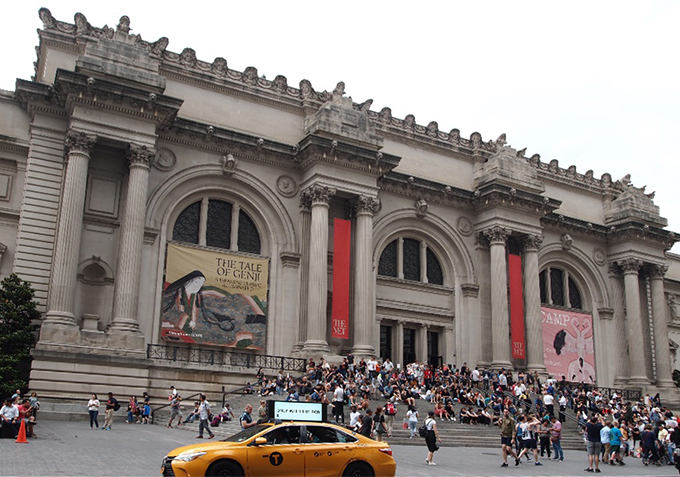
The Tale of Genji exhibition banner adorns the Metropolitan Museum of Art.
"Japan 2019" opened with The Tale of Genji: A Japanese Classic Illuminated, co-organized by the Metropolitan Museum of Art and the Japan Foundation (March 5 to June 16, 2019). Through the 138 works spanning various eras and genres, meticulously selected from 32 collections in Japan and the United States (including two National Treasures and nine Important Cultural Properties), the exhibition introduced the cultural trajectory of the impact of The Tale of Genji, considered the pinnacle of Japanese literature, on Japanese art for over 1,000 years. This was by far the most comprehensive exhibition of The Tale of Genji held overseas.
On March 4, 2019, the facade of the museum's main building, facing Fifth Avenue in New York City, was adorned with a huge banner of the Portrait-Icon of Murasaki Shikibu (by Tosa Mitsuoki). The exhibition opened on a solemn note with a consecration ceremony performed by Buddhist monks from Ishiyamadera Temple (Otsu City, Shiga Prefecture), with numerous affiliated persons and distinguished guests in attendance. On March 5, I visited the exhibition on the first day of its opening to the general public. There, I noticed two women with brilliantly shining eyes sighing with admiration. I couldn't help but speak with them and learned they were a mother and daughter on a sightseeing trip from Paris, France. The mother proclaimed that the appeal of Japanese culture is its "exquisiteness, elegance, precision and poetic sentiment." She admiringly told me, "The display method is really easy to understand and the works on display are fabulous." Throughout the entire exhibition, a constant stream of visitors of different nationalities, age, and gender, came as couples, families, friends or alone, and explored the exhibits in their own way.
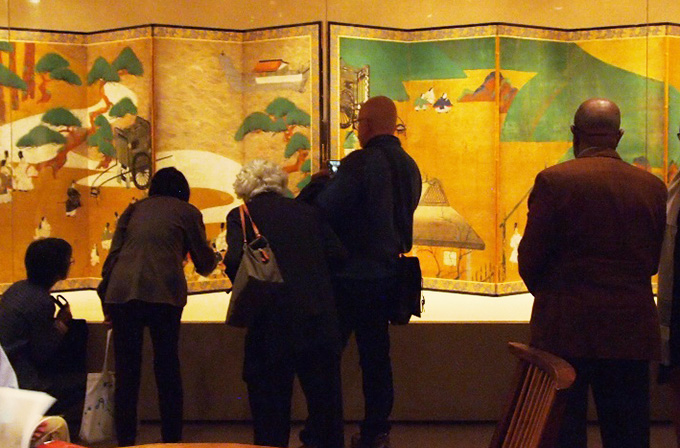
Visitors observe Tawaraya Sotatsu's Scenes from Sekiya and Miotsukushi Chapters of The Tale of Genji, a National Treasure (Seikado Bunko Art Museum collection).
The exhibition also featured an array of ancillary programs. These included a dialogue between Ms. Yamato Waki, author of Asaki Yumemishi, which chronicles The Tale of Genji in a manga format, and Professor Melissa McCormick, Professor of Japanese Art and Culture, Harvard University, co-curator of the exhibition; an academic symposium; a newly created opera depicting the life and work of Murasaki Shikibu, author of The Tale of Genji; and Genjiko Asobi (game of incense matching). The exhibition attracted more than 210,000 visitors. And a 368-page English-language catalogue, completed as a result of the efforts of the co-curators, Professor McCormick and Dr. John T. Carpenter, Mary Griggs Burke Curator of Japanese Art, The Metropolitan Museum of Art, is expected to contribute significantly to international studies of The Tale of Genji.
(2) Shinto: Discovery of the Divine in Japanese Art
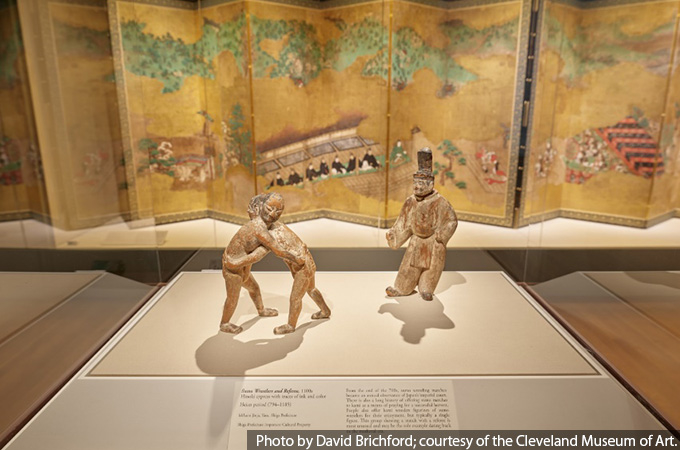
Shinto: Discovery of the Divine in Japanese Art brought together approximately 125 Shinto-related works.
The Cleveland Museum of Art is one of the foremost art museums in the U.S. Midwest. Shinto: Discovery of the Divine in Japanese Art was held at the museum with the special support of the Japan Foundation from April 9 to June 30, 2019. This marked the first time in 43 years that a full-scale special exhibition of Shinto, considered to be the wellspring of the Japanese spirit, has been held in the United States. This exhibition featured a collection of approximately 125 works (including 28 Important Cultural Properties and 1 Important Art Object) from Japan and the United States, and was comprised largely of Shinto-related paintings and sculptures from the Heian Period (794-1185) to the Edo Period (1603-1868) as well as masks and costumes used for Shinto rituals. Through six themes, such as entertaining the gods, faith in the Kasuga deities, and the syncretism of Shinto gods and Buddhas, the exhibition introduced the influence that the veneration of deities had on Japanese art over the centuries and endeavored to unravel the unique divine nature of Japan.
At the opening ceremony on April 8, 2019 and on the first day of the public exhibition on the 9th, with the cooperation of Miyajidake Shrine (Fukutsu City, Fukuoka Prefecture), a number of creative events and activities were provided to entertain visitors. These included performances of traditional Tsukushi-mai and Kagura-mai dances, handed down since ancient times as well as the establishment of a corner for displaying ema, small wooden plaques on which visitors were welcome to write their wishes and prayers, at the exit of the exhibition hall. Approximately 34,000 people attended this exhibition. The art critic of The Plain Dealer, a major Cleveland newspaper, also applauded the exhibition, commenting, "It's tempting to view such works merely as foreign and exotic, but the show is organized in ways that make it possible to grasp universal meanings." Also noteworthy was a comprehensive 292-page English-language catalogue published by Yale University Press as a result of the effort of exhibition curator Dr. Sinéad Vilbar, Curator of Japanese Art, Cleveland Museum of Art.
(3) The Life of Animals in Japanese Art
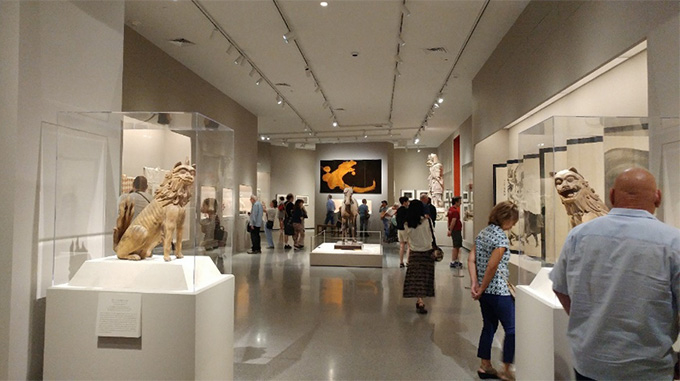
This exhibition was selected as one of "The Best Art of 2019" by The Wall Street Journal, a prominent U.S. newspaper.
The rich expression of co-existence between humans and animals is one important characteristic of Japanese art. The Life of Animals in Japanese Art, co-organized by the Japan Foundation, National Gallery of Art, Washington and the Los Angeles County Museum of Art, was held in Washington, D.C. from June 2 to August 18, 2019 and in Los Angeles from September 22 to December 8, 2019. The exhibition drew over 140,000 total visitors, and focused on the various animal expressions that have been deeply rooted in the lives, spiritual climate and religious views of Japanese people for more than 1,500 years, since the Kofun Period (ca. 300-700). With Mr. Robert T. Singer, Curator and Head, Department of Japanese Art, Los Angeles County Museum of Art, and Professor Kawai Masatomo, Director of Chiba City Museum of Art and Professor Emeritus of Keio University, serving as co-curators, the exhibition was held in collaboration with a wide range of art specialists from Japan and the United States. The over 300 works on display ranged from haniwa terracotta clay figures of the 5th century to contemporary art, comprised of a diverse array of media, including paintings, sculpture, lacquerwork, ceramics, metalwork, cloisonné enamel, woodblock prints, textiles and photography. The depiction of animals in these works, at times simple and humorous and at other times mystical, communicated charming aspects of Japanese culture to people of all ages. During the exhibition, various related programs were held, including lectures, gallery talks, a symposium, a Japanese music concert, animal-themed Japanese film series and family-oriented Japanese cultural programs.
This exhibition was selected by The Wall Street Journal as one of "The Best Art of 2019." The newspaper highly praised the exhibition, commenting, "For pure delight, [the exhibition] was unbeatable. Many works were memorable [and] irresistible." In a special feature article titled, "The Decade in Review," The Wall Street Journal also cited the exhibition as a good example of art museums still organizing meaningful exhibitions despite the trend toward commercialism in the U.S. art world over the past 10 years. The Washington Post commented, "Like the beautifully curated "Tale of Genji" exhibition now at the Metropolitan Museum of Art, the National Gallery show was co-organized by the Japan Foundation [...] that is easily, happily and [...] fully family friendly. But it's also a rich and intellectually rewarding show that makes real what is often discussed but rarely realized in similar exhibitions ― the power of cultural exchange."
Stage Performance (1) National Cherry Blossom Festival
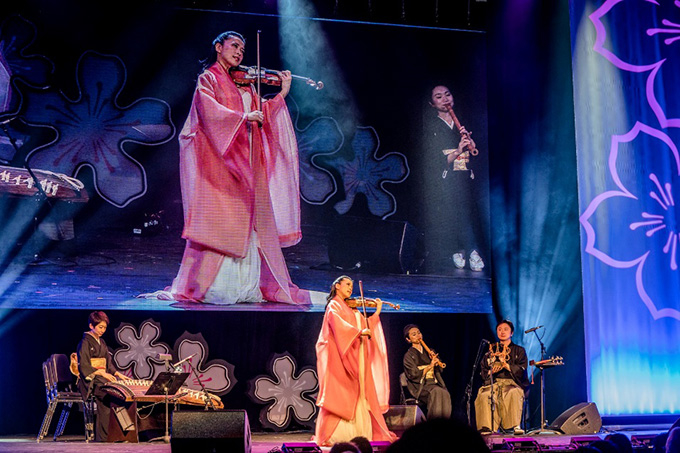
Ms. Kawai Ikuko, dressed in a cherry-colored costume, played the violin to a mesmerized audience.
Held annually in March and April in Washington, D.C., the National Cherry Blossom Festival is a citywide festival that celebrates the arrival of spring and Japan-U.S. friendship in the nation's capital. The gorgeous blossoms of the cherry trees donated in 1912, by then Tokyo mayor Ozaki Yukio, bloom along the banks of the Potomac River as a symbol of goodwill between Japan and the United States. Each year, the festival welcomes over 1.5 million visitors during the four-week period. On March 23, 2019, the opening ceremony of the festival was held at the Warner Theatre near the White House. The Japan Foundation dispatched three performing groups from Japan: Kawai Ikuko & Wagakki Ensemble performed in a collaboration that featured a violin and traditional Japanese instruments based on the theme of The Tale of Genji; Mr. Mochizuki Yusaku (Mochi) combined juggling with media art utilizing advanced video technology; and the 2.5-dimensional musical "Pretty Guardian Sailor Moon" The Super Live, a spectacle filled with fast-paced dance and songs based on the globally popular manga Sailor Moon. Each of these showcase performances earned rousing cheers from the packed audience and brought excitement to the opening ceremony.
On the afternoon of the 24th, a concert by Kawai Ikuko & Wagakki Ensemble was held at the Freer Gallery of Art and Arthur M. Sackler Gallery, Smithsonian Institution. This performance was so popular that there was a long line waiting to take advantage of any last minute ticket cancellations. The Tale of Genji screens, too valuable and delicate to be taken off the premises, were also displayed in the gallery. There, visitors were captivated not only by the sound of the elegantly attired Ms. Kawai and her violin but also by her Genji recitation featuring first-rate performers playing traditional Japanese instruments such as the biwa lute, shakuhachi bamboo flute, koto harp, nohkan flute and a tsuzumi drum. That evening, the full performance of "Pretty Guardian Sailor Moon" The Super Live was held at the Warner Theatre, for which tickets quickly sold out. Avid fans, including some from Canada, flocked to the theater and greeted the North American debut performance of the 2.5-dimensional musical with thunderous cheers. Besides young cosplayers, the theater was filled with an audience of all ages. The "Pretty Guardian Sailor Moon" cast put their heart and soul into a sustained, highly physical performance that was met with exuberant applause and passionate cheers and brought down the house. Witnessing the explosive energy of Japan's pop culture was indeed overwhelming. This production later moved on to New York with three additional, wildly successful performances at PlayStation Theater on Broadway on March 29 and 30, 2019; all shows were sold out.
(2) Japan Day
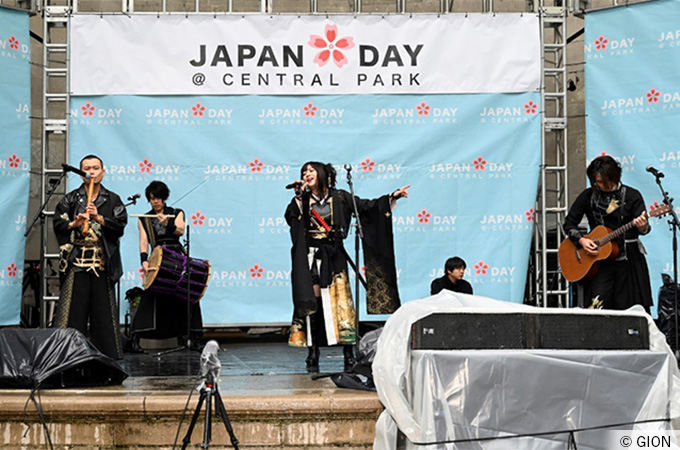
Wagakki Band performs at Japan Day.
Japan Day, an annual outdoor festival, was held on May 12, 2019 in New York's Central Park. This festival aims to introduce Japanese culture and promote exchange between Japanese and U.S. citizens. This year marked the 13th year of the festival and featured main-stage performances by Kai Yoshihiro Band led by rock musician Mr. Kai Yoshihiro as well as Wagakki Band. Additionally, areas for experiencing Japanese culture and sampling Japanese food were set up at various locations throughout the park. Despite untimely rain, approximately 25,000 people of all ages savored the multifaceted flavor of Japan.
(3) Japan Night
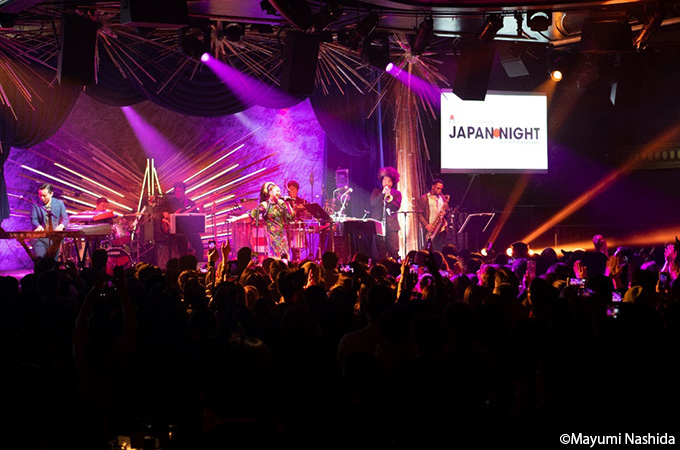
MISIA demonstrated her powerful voice during her Japan Night performance.
Following Japan Day at Central Park, the venues shifted to PlayStation Theater and Sony Hall on Broadway on that night. Here, the Japan Foundation and partner companies from Japan and the United States co-organized Japan 2019 presents Japan Night. This special one-night only event featured live performances by four groups of artists leading Japan's music scene, HYDE, Wagakki Band, MISIA and Puffy AmiYumi, as well as renowned calligrapher Sisyu. The evening aimed at promoting exchanges between younger generations of Japan and the United States. Undaunted by the steady rain, a long line formed and tickets were sold out even before the doors opened. Each of these unique and powerful J-POP stage performances earned energetic cheers from about 3,000 enthusiastic music fans. Video clips from the shows were later aired on Japanese TV programs. May 1, 2019 ushered in the change in the name of the era marking the Emperor's reign, which made this an ideal opportunity to celebrate the start of Japan's new Reiwa era in New York.
(4) Miyagi Satoshi's Antigone
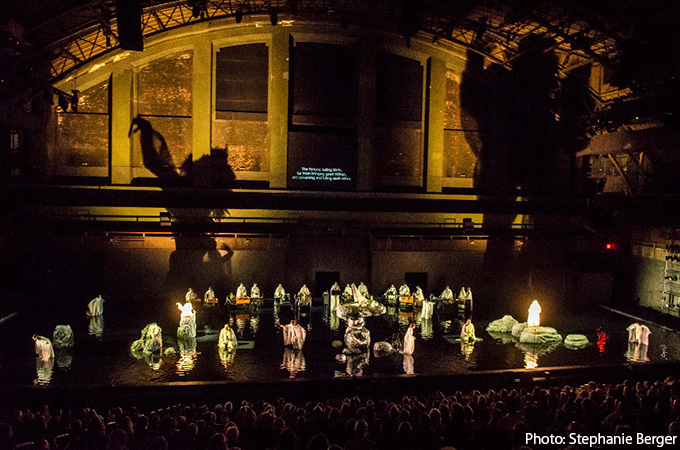
Antigone earned so much acclaim that tickets sold out one day after opening day.
Gracing New York's Park Avenue with its majestic presence, Park Avenue Armory was completed in 1880 as a military facility and a social club for the Seventh Regiment of the New York State Militia, which fought as part of the Union Army during the American Civil War. Covered by an arched roof typifying a European railway station, the Armory is designated as a National Historic Landmark along with the recognition of the importance of interior design undertaken by Louis Comfort Tiffany. Today, the Armory has established a solid reputation as a venue that introduces high-level art from around the world and is strongly supported by New Yorkers. From September 25 to October 6, 2019, the Japan Foundation, in collaboration with Park Avenue Armory and Shizuoka Performing Arts Center (SPAC), presented 12 consecutive performances of Antigone directed by Mr. Miyagi Satoshi, one of Japan's premier directors. Antigone received a rave review in The New York Times as a Sophocles' Greek tragedy interpreted from a Japanese Buddhist perspective. Tickets for all performances were sold out only one day after its opening. At one point, a ticket even commanded a premium price of US$1,890 on a ticket resale site, more than 10 times the regular ticket price. TIME magazine ranked Antigone among "The 10 Best Theater Performances of 2019."
Within the spacious confines of the Armory, water resembling the Sanzu River filled the Antigone stage while actors in white costumes embarked on a dream-like performance, which incorporated Japanese elements such as Noh, Bunraku and the Bon festival dance. Antigone combines the concept of "when we die, we all become Buddhas," the unique Japanese view of life and death, with the ideas of Princess Antigone, who does not distinguish between friend and foe. Resonating with the Armory's genius loci, Antigone emphasized the futility of conflict and division and of each struggle. These performances aroused deep emotions from audiences that totaled over 10,000 people. This sentiment was further substantiated by the unanimous acclaim of viewers, who voiced such comments as "[It was] the most extraordinary experience of witnessing the most noble and aesthetically enhancing treatment of Sophocles' epic text Antigone! Words cannot describe the degree of amazement!" and "Antigone swayed my heart rather than my mind." I should point out that the audience was not limited to ordinary art enthusiasts. At an educational performance held on October 2, 2019, the venue was filled with 12- to 17-year-old students who attend public schools in New York. The young, diverse audience from across the city fidgeted with effusive energy prior to the start of the performance. However, once the performance began, the students were completely riveted and their heartwarming standing ovation at the end of the performance was truly impressive.
During its run of performances, in addition to a public talk with the director, Mr. Miyagi, there were other related events such as "Discover Shizuoka Projects" sponsored by Shizuoka Prefectural Government, mainly targeted professionals in the media and travel industries.
Editorial note: Japanese readers can enjoy the Stage Natalie article, on this SPAC Antigone New York performance report and interview with Miyagi Satoshi at:
https://natalie.mu/stage/pp/antigone
(5) Sugimoto Bunraku Sonezaki Shinjū: The Love Suicides at Sonezaki
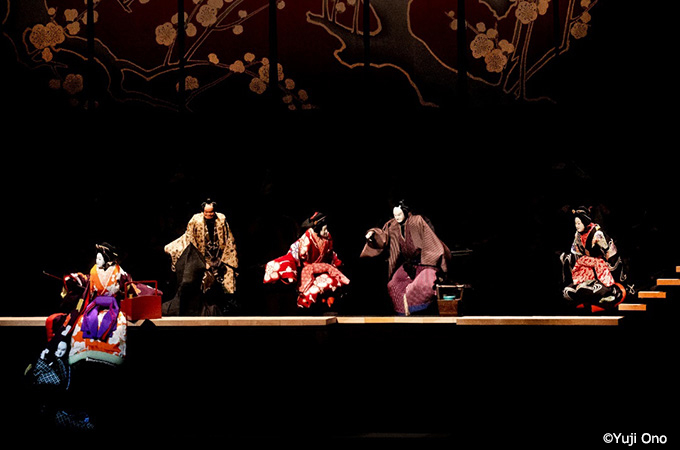
Sugimoto Bunraku Sonezaki Shinjū performed at the opening of Lincoln Center's White Light Festival.
Lincoln Center is one of the world's largest comprehensive performing arts complexes and the pride of New York City. Held every fall, Lincoln Center's White Light Festival is a multidisciplinary art festival that illuminates the many dimensions of our interior lives. Celebrating its 10th anniversary, the 2019 festival opened on October 19 with Sugimoto Bunraku Sonezaki Shinjū: The Love Suicides at Sonezaki, presented in association with the Japan Foundation and Odawara Art Foundation. Ningyo joruri bunraku puppet theater, registered as a UNESCO's Intangible Cultural Heritage of Humanity, was performed in its authentic form in New York for the first time in 27 years. This work was a contemporary adaptation of the original work by Chikamatsu Monzaemon. Mr. Tsurusawa Seiji, Living National Treasure for the shamisen, composed the music and Mr. Sugimoto Hiroshi, Person of Cultural Merit, a world-renowned contemporary artist, adapted and directed the work that included his own stage art. The production attracted major attention when the festival's lineup was announced, and all four performances played to a full house. A total of nearly 4,000 audience members immersed themselves in the world of this tragic love story of Ohatsu and Tokubei.
This work blends the dynamic storytelling by tayu chanters whose voices convey rich emotions in cadence; flawless shamisen performance ― at times bewitching and at times cutting like a sharp-edged knife; along with the elaborate movements of dolls manipulated by the superb teamwork of puppeteers. The mystique of this artistic trinity wonderfully fuses the simple and elegant stage art permeated with Mr. Sugimoto's aesthetics and enriched by the lively and colorful video work of Tabaimo. With breathless intrigue, the audience at the sold-out venue watched the unfolding of the story based on the actual double suicide of lovers that happened in Osaka over 300 years ago. When the curtain came down concurrently with the poignant closing line, "Without doubt these lovers will attain Buddhahood and become...models of true love," the theater became shrouded in pitch darkness and complete silence. The next moment, thunderous applause erupted from the audience. This theme of fulfilling love in the afterlife through the lovers' double suicide is deeply rooted in the Japanese view of life and death. While I was worried about how this would be accepted in the United States, I believe the deep emotion of this work was adequately communicated after witnessing that some of the audience members were moved to tears. Asked their impressions, viewers unanimously extolled the clear beauty of this work. We received comments such as, "This was a strange experience where human emotions were realistically conveyed even better than when actual humans act" and "The performance was perfect and the play is so moving." The North American debut performance of Sugimoto Bunraku Sonezaki Shinjū, which coincided with the enthronement ceremony of His Majesty the Emperor in Japan, was one of the highlights of the fall 2019 New York cultural scene.
Associated Program
In addition to the eight official events outlined above, 138 events introducing Japanese culture and promoting Japan-U.S. exchange were held under the auspices of the "Japan 2019" associated program across the United States through the end of December 2019. One of these was the Japanese film festival "SHITAMACHI: Tales of Downtown Tokyo" commenced on October 18, 2019. This was co-organized by the Japan Foundation and Film Forum, New York's representative independent movie house. This special screening of 38 masterpieces set in the downtown neighborhoods of Tokyo produced over the course of around 80 years, from 1929 to 2004, was widely featured in The New York Times and The New Yorker magazine. More than 4,500 people attended the screenings. Director Ozu Yasujiro's Tokyo Story (1953) enjoyed especially high popularity, prompting additional screenings. The film festival was extended by one week and ran a total of four weeks, to November 14. Another example is the exhibition, Kyoto: Capital of Artistic Imagination, at the Metropolitan Museum of Art that opened on July 24, 2019 and is expected to run through September 20, 2020*. The number of visitors surpassed 300,000 as of this writing (end of January 2020).
The Universality of Japanese Aesthetics
How were the various cultural programs implemented as part of "Japan 2019" accepted in the United States? For the eight official projects alone, there were nearly 400 media reports, mainly in the United States and Japan. While there is not enough space nor time here to analyze each report in detail, summarizing reviews in major U.S. newspapers, it seemed quite evident that most of the art critics uncovered, from the breadth of artistic expressions presented, the Japanese disposition and views on nature and human life cultivated over the country's long history. Further, it was also remarkable that some of these critics strived to find some commonalities and shared universal values with the United States. As an individual involved in the preparation and implementation of "Japan 2019," I would be most delighted if this series of programs provided American audiences with profound joy and inspiration, offered an opportunity for discovery and realization, as well as broadened the understanding of the fundamental thinking of Japanese people.
Sustainable Growth of Japan-U.S. Exchanges
Finally, the high-quality programs that introduced Japanese arts and culture were not realized in a day. I wish to make clear that the presence and cooperation of cultural experts in both Japan and the United States were essential in the realization of "Japan 2019." For example, all three exhibitions held under the auspices of the official program were curated by American curators who studied Japanese art at graduate schools in Japan as Japan Foundation Fellows. The large-scale exhibitions of "Japan 2019" were the crystallization of their deep knowledge and understanding of Japanese culture; perspectives unique to non-Japanese; and tireless passion and devoted efforts toward arts and cultural exchanges between Japan and the United States.
Professor Melissa McCormick at Harvard University, who co-curated The Tale of Genji exhibition with Dr. John T. Carpenter, Curator of Japanese Art at The Met, was a Japan Foundation Fellow at Gakushuin University in FY1995. Dr. Monika Bincsik, Associate Curator of Japanese Decorative Arts at The Met, not only collaborated on the Genji exhibition but also curated the Kyoto exhibition and was a Japan Foundation Fellow at Kyoto University in FY2006. Dr. Sinéad Vilbar, Curator of Japanese Art at the Cleveland Museum of Art, who curated the Shinto exhibition, was a Japan Foundation Fellow at Tohoku University in FY2002. Mr. Robert T. Singer, Curator and Head of the Department of Japanese Art, Los Angeles County Museum of Art, was a co-curator of The Life of Animals exhibition and a Japan Foundation Fellow at Kyoto University in FY1974, just after the establishment of the Foundation in 1972.
While requiring quiet yet persistent tending, providing support long into the future for specialists who have both Japanese and American perspectives and strengthening their networks is an indispensable process for the continuous deepening of Japan-U.S. exchanges and the perpetual development of Japan-U.S. relations. In this sense, perhaps "Japan 2019" can be viewed as an excellent example of a beautiful flowering of the seeds previously planted by Japan-U.S. exchanges. To consider the success of "Japan 2019" a prologue to an even higher dimension of arts and cultural exchanges between Japan and the United States, we must never forget the importance of sowing such seeds and building an ever-growing infrastructure.
*The museum is temporarily closed due to COVID-19 as of July 17, 2020.

https://www.jpf.go.jp/e/about/area/japan2019/
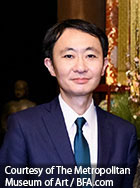
Matsumoto Kenji
Received B.A. in Social Sciences from Hitotsubashi University and M.Sc. in Geography from the Graduate School of Science, The University of Tokyo. Joined the Japan Foundation in 1999. Worked at Japanese Studies Department; the Japan Foundation, New York; Overseas Policy Planning Department; as Deputy Director at the Japan Cultural Institute in Cologne; as Director of Americas Section, Arts Department; among others. In 2016, he became Deputy Director General of the Japan Foundation, New York. Since February 2020, he serves as Director of Arts, Culture and Exchange Section I of the Japan Foundation Asia Center. He is also a Nitobe Leadership Fellow of the International House of Japan.
Keywords
- Anime/Manga
- Pop Culture
- Traditional Arts
- Cultural Heritage
- Theater
- Arts/Contemporary Arts
- Performing Arts
- Music
- Philosophy/Religion
- History
- Americas
- North America
- United States
- Japan 2019
- The Tale of Genji
- Murasaki Shikibu
- Shinto
- Japanese art
- National Cherry Blossom Festival
- Kawai Ikuko
- Kai Yoshihiro Band
- Wagakki Band
- Sisyu
- Japan Day
- Japan Night
- Antigone
- Miyagi Satoshi
- Sugimoto Bunraku
- Sugimoto Hiroshi
- Sonezaki Shinjū
- Ningyo joruri bunraku
Back Issues
- 2023.12. 7 Movie Theaters aroun…
- 2023.6.16 The 49th Japan Found…
- 2023.4.24 The 49th Japan Found…
- 2022.12.27 Living Together with…
- 2022.12.27 Living Together with…
- 2022.8.12 Inner Diversity <…
- 2022.3.31 The 48th Japan Found…
- 2022.3.29 Beyond Disasters - T…
- 2021.11.29 Crossing Borders, En…
- 2021.4.13 Crossing Borders, En…

